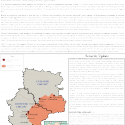 |
 |
Ukraine Update: Russia's Active Campaign in Ukraine
May 15, 2017 - ISW Press


By: Benjamin Knudsen, Alexandra Lariiciuc, and Franklin Holcomb
Key Takeaway: Russia has continued its destabilization campaign in Ukraine using its proxy forces and other means of subversion. The Trump Administration has indicated it is willing to support Ukraine as the Eastern European country faces Russian aggression. President Trump must act to strengthen the U.S.-Ukraine partnership and increase pressure on Russian President Vladimir Putin as part of a broader campaign to deter Russian aggression globally.
U.S. officials emphasized their support for Ukraine in a series of diplomatic meetings in May. U.S. President Donald Trump held separate meetings with Russian Foreign Minister Sergey Lavrov and Ukrainian Foreign Minister Pavlo Klimkin in Washington on May 10 during which he reportedly stressed “Russia’s responsibility to fully implement the Minsk agreements.” This rhetoric echoes previous statements by Trump administration officials. U.S. Secretary of State Rex Tillerson said the U.S. will maintain sanctions against Russia “until Moscow reverses the actions that triggered them.”
Russia nevertheless continued to fuel the war in Ukraine and destabilize the country politically while waging a disinformation campaign to portray Ukraine as the aggressor. Russian-backed separatist forces violated their obligations under the Minsk Ceasefire Agreement. They resumed attacks against Ukrainian forces near the strategic cities of Mariupol, Donetsk, and Popasna following a brief lull for the celebration of Orthodox Easter on April 16. Russia resisted efforts to deploy international peacekeepers in order to preserve its proxies’ freedom of action. Russia also continued to exploit social tensions in Ukraine. Pro-Russia hooligans clashed with pro-Ukrainian activists, nationalists, and law enforcement personnel across Ukraine during Victory Day Celebrations on May 9. These provocations failed to create widespread public discontent, but demonstrate the persistent Russian-backed campaign to destabilize Ukraine from within. Russia also likely continues to try and undermine Ukraine’s relationships with European nations. Unidentified assailants attacked Polish and Lithuanian diplomatic facilities in Lutsk on March 29 and Kyiv on April 24, respectively. Ukrainian and Polish officials previously accused Russia of using similar incidents to drive a wedge between Ukraine and its Eastern European partners.
Ukraine’s government made progress in combating corruption and creating a favorable business environment as it confronts a stagnant economy. President Petro Poroshenko expanded the critical e-declaration system on March 27, through which Ukrainian government officials must publicly reveal their assets. Ukraine also launched a number of corruption investigations into officials in the banking and government sectors. Ukraine’s Ministry of Economic Development and Trade announced that the GDP decreased from projected estimates due to the ongoing conflict. The financial burden from the war has contributed to slow economic growth, which increasingly undermining public confidence in the government.
The U.S. must not only support Ukraine in its economic and political reform efforts, but also take a strong stance against Russia’s aggression. Previous levels of Western pressure have failed to effect a significant change in the Kremlin’s policy toward Ukraine, including in the period since President Trump took office. Russian President Vladimir Putin will likely fuel the war and foment instability until he returns Ukraine under his sphere of influence or until the cost of continued aggression becomes unacceptable. The U.S and its allies must support Kyiv’s efforts to maintain a stable economy, advance political reforms, and strengthen the Armed Forces of Ukraine, or risk growing Russian aggression and subversion in a country and region vital to America’s national interests.